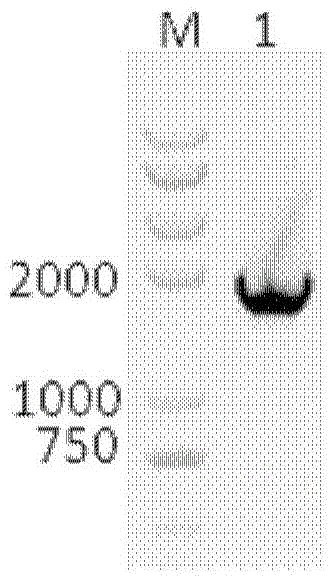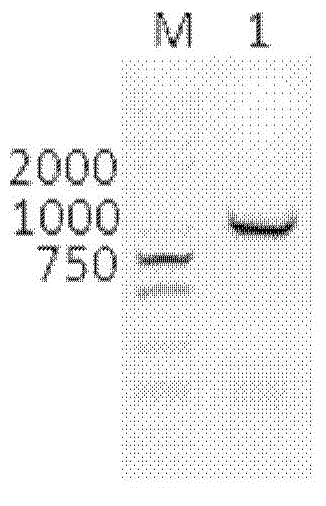3-phosphoglyceric kinase promoter and terminator and applications thereof
A phosphoglycerate kinase and promoter technology, which is applied in the field of genetic engineering, can solve the problem that the promoter sequence report of T. dermoides has not been seen, that it is not applicable to lipid yeast and T. stipitis, restricts strain modification, etc. problems, to achieve the effect of promoting strain improvement and metabolic engineering research
- Summary
- Abstract
- Description
- Claims
- Application Information
AI Technical Summary
Problems solved by technology
Method used
Image
Examples
Embodiment 1
[0087] Example 1: Extraction of total RNA from Lipomycessstarkeyi NRRLY-11557
[0088] L. starkeyi NRRLY-11557 (purchased from the American Agricultural Research Culture Collection (NRRL), Bacterial Foodbome Pathogens & Mycology Research, 1815N.University Street IL61604.Peoria, Illinois) was inoculated into 50ml YEPD liquid medium (glucose 20.0g / l, yeast extract 10.0g / l, peptone 20.0g / l, pH6.0), cultured on a shaker at 30°C for 24h, and then transferred the bacterial solution to 100ml YEPD liquid medium at a volume ratio of 1:50 cultured on a shaker at 30°C for 12 hours to reach the logarithmic growth phase. Centrifuge at 5000 rpm for 4 minutes at 4°C to collect the cells, freeze the cells quickly with liquid nitrogen, and grind to break the wall. Total RNA was extracted using the TakaRa RNAiso kit and following its standard procedures.
[0089] The RNA was subjected to 1.5% agarose gel electrophoresis, observed and identified using a fluorescence-ultraviolet analyzer, and ...
Embodiment 2
[0090] Example 2: First-strand synthesis of L. stardii NRRLY-11557 cDNA and PGK degenerate PCR
[0091] The first-strand cDNA was synthesized by reverse transcription using the total RNA of L. stariae NRRLY-11557 as a template. First, 1.0 μl total RNA (about 2 μg), 1.0 μl primer SMARTIV: 5′-AAGCAGTGGTATCAACGCAGAGTGGCCATTACGGCCGGG-3′ and 1.0 μl ligodT-linker primer CDSIII / 3′: 5′-ATTCTAGAGGCCGAGGCGGCCGACATG-d(T) 30N-1 N-3′, 2.0 μl of DEPC-treated water (diethyl pyrocarbonate-treated water, purchased from Dalian TakaRa Company), was added to a PCR tube and mixed evenly, kept at 72°C for 2 min, immediately placed on ice for 2 min, and 2.0 μl of 5 ×The first strand buffer (Clontech Company), 1.0 μl DTT (20 mM), 1.0 μl IdNTP (10 mM), 1.0 μl powerscript reverse transcriptase (Clontech Company) were added to the system, and mixed. Extend the reaction at 42°C for 60 minutes, and end the reaction at 4°C, and store it at -20°C for later use.
[0092] Design and synthesize two degenerat...
Embodiment 3
[0093] Example 3: Amplification of L. studleyi NRRLY-11557 Genomic DNA
[0094] Genomic DNA of L. stariae NRRLY-11557 was extracted by glass bead wall breaking method (Chapter 13 of the third edition of the Molecular Biology Experiment Guide, Osper et al., translated by Yan Ziying et al., published by Science Press). The prepared genomic DNA was measured by Nanodrop1000, and the OD was measured 260 / OD 280=1.85, indicating that the quality of genomic DNA is very good. The concentration was 120ng / μl, 500μl in total, and the genomic DNA samples were frozen at -20°C for future use.
[0095] According to the 3-phosphoglycerate kinase cDNA sequence obtained in Example 2, design a pair of gene-specific primers, PGK-p1: 5'-ATGCTTAACCTCAAAGTATCTGTT-3' and PGK-p2: 5'-TTAGAACTTCTGCTCGACATCT-3', Es Genomic DNA of L. dablii NRRLY-11557 was used as a template, PCR amplification was performed according to conventional methods, and a PCR product of about 1.6 kb was obtained (not shown). ...
PUM
 Login to View More
Login to View More Abstract
Description
Claims
Application Information
 Login to View More
Login to View More - R&D
- Intellectual Property
- Life Sciences
- Materials
- Tech Scout
- Unparalleled Data Quality
- Higher Quality Content
- 60% Fewer Hallucinations
Browse by: Latest US Patents, China's latest patents, Technical Efficacy Thesaurus, Application Domain, Technology Topic, Popular Technical Reports.
© 2025 PatSnap. All rights reserved.Legal|Privacy policy|Modern Slavery Act Transparency Statement|Sitemap|About US| Contact US: help@patsnap.com



